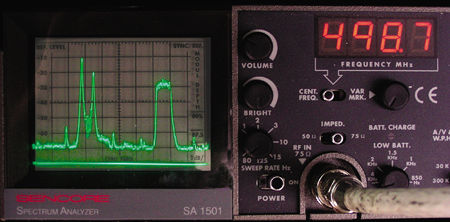There's HDTV In Them Thar Hills
UAV editor Tom Norton Gets Hooked Up for Broadcast HDTV
As the momentum builds for HDTV, one of the things that have kept the transition from moving faster is the by-fits-and-starts rollout of terrestrial digital television, aka broadcast DTV. As of this writing, more than 1200 broadcast stations are sending out some sort of digital signal, whether it be 24/7 at full power, for a limited number of hours each day, and/or at reduced power. Markets such as Los Angeles are saturated with DTV signals; others, such as Denver, are still stalled due to problems with zoning ordinances and legal maneuvers.

Even so, chances are you have a DTV broadcaster nearby that's on the air, or close to lighting up their antenna. That means you might be able to watch such high-definition TV shows as N.Y.P.D. Blue, CSI, or The West Wing—or HD sporting events, including the Super Bowl, US Open tennis and golf, NHL Hockey, and NBA basketball—all for free.
That's right: for free. This assumes you have a DTV receiver, an antenna of some sort, and an HDTV-ready TV. If you do, there's no reason you can't get and enjoy broadcast HDTV programs, even if you already have HDTV over cable, or from digital broadcast satellite (DBS).
In fact, many broadcast stations are carried on neither satellite nor cable, so you might wait a long time for your cable/DBS operator to add your favorite network programs. With off-air reception, you can start enjoying them now.
I've been watching broadcast DTV and HDTV programs since fall 1999. Philadelphia was one of the more active markets, and many of our HD stations were up and running by June 2000, including all the major networks. We now have 13 local DTV stations, including stations from nearby Allentown, Pennsylvania and Trenton, New Jersey. I can also watch three DTV stations from New York City, even though those signals originate from 65 miles away. All it takes is a modest rooftop antenna with rotor, plus a weak signal preamplifier.
My experiences with DTV in the past four years haven't been limited to viewing. Having more than 30 years' experience with antennas and RF signal propagation as a ham radio operator, I've conducted extensive field tests of DTV reception in such diverse locations as Beverly Hills, South Philadelphia, Midtown Manhattan, New Paltz, New York, and Portland, Maine. Here's what I've learned:
• DTV works better than many people (including TV station engineers) think.
• Setting up to watch off-air DTV is more like setting up a satellite system.
• DTV signals can be received over far greater distances than analog TV signals.
• It's all in the antenna!
That'll Never Work
For some time, I'd been asking Ultimate AV editor Tom Norton if he was enjoying broadcast HDTV programs at his home in the Los Angeles area. Each time, his answer was, "No, it won't work. There's a hill between me and the transmitter on Mt. Wilson." Finally, I asked Tom if he'd actually tried to receive DTV broadcasts. He had not. [Actually, I had tried to receive analog over-the-air signals, but, finding that hopeless, made the common error of assuming that receiving DTV would be a similar waste of time. I had resigned myself to getting the high-definition material I needed for evaluating gear from the slowly growing HD service on my local Charter Communications cable system and the not-much-faster growing catalog of D-VHS titles.—TJN]

A typical DTV signal (from KYW, in Philadelphia).
So when I found myself in L.A. to deliver a talk at the HDTV Forum, I was able to schedule an extra free day to come up to Tom's house and see for myself if he really couldn't pick up off-air DTV programs. Having visited the area once before, in 2001, to run some off-air reception tests, I was confident we could pick up a few. After all, I'd managed to pull in eight or nine DTV stations in some pretty diverse terrains, ranging from the shores of Malibu to the canyons of Beverly Hills.
To understand how this is even possible, you need to know a little bit about DTV signals. Unlike an analog TV signal, whose picture quality is directly related to the signal's strength, a DTV signal operates within a "threshold" system. That is, the signal must be at a certain level above the background noise before you can tune it in. Once you do tune in that signal, a steady stream of digital picture and audio data is fed to your TV, free from snow, ghosts, and other analog artifacts. The audio is crystal-clear stereo or surround sound. In short, the video and audio quality should be as good as when it left the station.

A comparison of DTV (left) and analog (right) TV signals.
However, if the DTV signal drops below the required carrier-to-noise (C/N) threshold, the picture and audio simply stop streaming. This phenomenon is known as the "cliff effect"—it's as if the signal suddenly fell off a cliff.
The trick is to make the DTV signal as strong as possible, and to minimize echoes of the signal (multipath), which could interfere and cause picture and audio dropout. That's a difficult job in a city; it's also a problem in fringe areas, as well as locations where your view of the transmitting antenna is blocked.
HDTV Is Where You Find It
There are a few ways you can sniff around for DTV signals. The first method is by blind faith—you simply turn on a set-top receiver, tune in a channel that you know or hope is active, and rotate the antenna until something comes in. This can get old in a hurry.

The elevated noise at Tom's house.
The second method is a bit more scientific. If you know what DTV channels are active in your area, you can simply tune in the regular analog TV channels on a portable TV, and rotate and position the antenna for best overall picture. Once you have that established, you have a good chance of getting the digital versions; many stations' digital transmitters are in same locations as their analog transmitters.
The third method is to use a signal-strength meter to orient the antenna for maximum signal output. This is an even better approach, but such meters aren't cheap. Nor can they provide level readings of really weak signals, which is what some viewers will have to deal with.


























































